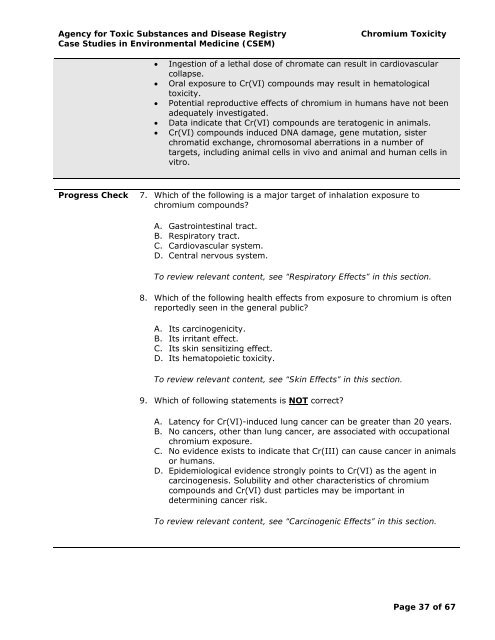(Cr) Toxicity | ATSDR - CSEM - Agency for Toxic Substances and ...
(Cr) Toxicity | ATSDR - CSEM - Agency for Toxic Substances and ...
(Cr) Toxicity | ATSDR - CSEM - Agency for Toxic Substances and ...
Create successful ePaper yourself
Turn your PDF publications into a flip-book with our unique Google optimized e-Paper software.
<strong>Agency</strong> <strong>for</strong> <strong>Toxic</strong> <strong>Substances</strong> <strong>and</strong> Disease Registry Chromium <strong><strong>Toxic</strong>ity</strong><br />
Case Studies in Environmental Medicine (<strong>CSEM</strong>)<br />
Progress Check<br />
• Ingestion of a lethal dose of chromate can result in cardiovascular<br />
collapse.<br />
• Oral exposure to <strong>Cr</strong>(VI) compounds may result in hematological<br />
toxicity.<br />
• Potential reproductive effects of chromium in humans have not been<br />
adequately investigated.<br />
• Data indicate that <strong>Cr</strong>(VI) compounds are teratogenic in animals.<br />
• <strong>Cr</strong>(VI) compounds induced DNA damage, gene mutation, sister<br />
chromatid exchange, chromosomal aberrations in a number of<br />
targets, including animal cells in vivo <strong>and</strong> animal <strong>and</strong> human cells in<br />
vitro.<br />
7. Which of the following is a major target of inhalation exposure to<br />
chromium compounds?<br />
A. Gastrointestinal tract.<br />
B. Respiratory tract.<br />
C. Cardiovascular system.<br />
D. Central nervous system.<br />
To review relevant content, see “Respiratory Effects” in this section.<br />
8. Which of the following health effects from exposure to chromium is often<br />
reportedly seen in the general public?<br />
A. Its carcinogenicity.<br />
B. Its irritant effect.<br />
C. Its skin sensitizing effect.<br />
D. Its hematopoietic toxicity.<br />
To review relevant content, see “Skin Effects” in this section.<br />
9. Which of following statements is NOT correct?<br />
A. Latency <strong>for</strong> <strong>Cr</strong>(VI)-induced lung cancer can be greater than 20 years.<br />
B. No cancers, other than lung cancer, are associated with occupational<br />
chromium exposure.<br />
C. No evidence exists to indicate that <strong>Cr</strong>(III) can cause cancer in animals<br />
or humans.<br />
D. Epidemiological evidence strongly points to <strong>Cr</strong>(VI) as the agent in<br />
carcinogenesis. Solubility <strong>and</strong> other characteristics of chromium<br />
compounds <strong>and</strong> <strong>Cr</strong>(VI) dust particles may be important in<br />
determining cancer risk.<br />
To review relevant content, see “Carcinogenic Effects” in this section.<br />
Page 37 of 67

















